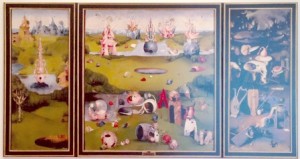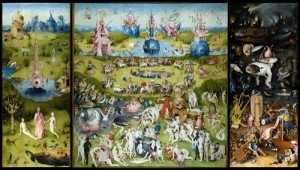Posted April 7, 2013
By MELISSA CASTILLO
Francisco Goya’s famous painting, “The Third of May 1808: The Executions on Principe Pio Hill,” portrays soldiers pointing their guns at a group of men as they plead for mercy, while bodies surrounded by blood lie next to them.
This is a gruesome and historic portrayal of the Spanish resistance to Napoleon’s armies during the Peninsular War.
Contemporary Spanish photographer Jose Manuel Ballester actually dared to dramatically alter this monumental piece of artwork.
And he earned respect for it through his collection “Concealed Spaces.”
Ballester’s depiction of Goya’s painting, which he titled “3 of May,” expels all forms of life that existed in the original, leaving only a glowing light that was half covered by the soldiers, its shadow and the pool of blood.
He does this with several other works by notable painters including Leonardo da Vinci, Sandro Botticelli, Fra Angelico, Diego Velazquez, Hieronymus Bosch, Claude Lorrain and Johannes Vermeer.
The collection of 24 large-scaled photos is displayed at the Patricia and Phillip Frost Art Museum at Florida International University’s Modesto A. Maidique Campus. This is the award-winning photographer’s first individual exhibition in the United States.
His originality was acknowledged in 2010 when he received the National Photography Prize granted by the Ministry of Culture of Spain for his distinguishing representation of architectural space and light and his contribution to contemporary photographic techniques.
His technique with this collection is to first take photos of the original paintings, which are in the Museo de Prado in Madrid. Then he digitally removes any people, animals, or action and fills in their absence by adding to the background using Photoshop and similar programs.
It’s also clear from comparing the original painting and the final photograph that he edited the contrast level to create a more dramatic effect between light and dark. This is seen in “Artist’s Studio,” which derived from Johannes Vermeer’s “The Art of Painting.”
The curtain that hangs in the first layer of the photo is almost entirely black and lacks the intricate details seen in the original painting. Contrasting this against a bright light shining from behind the curtain enhances the depth in the photo and almost looks as though the objects are protruding off of the canvas.
By getting rid of the usual subjects, in this case an artist and a woman modeling for him, there is more appreciation given to the architectural interior. His goal is to rid the paintings of any narrative and discover new layers open for interpretation in nature and architecture. He intensifies the significance of the backdrops in these historic paintings and transforms them to being the actual subjects.
The lack of human subjects in some of the photos of nature is surprisingly breathtaking. For instance, “Port in Ostia,” based on Claude Lorrain’s “Port of Ostia with the Embarkation of St. Paula,” doesn’t have crowds of ships along the docks and it doesn’t have crowds of people on the docks.
Erasing these factors and leaving only a couple gondolas instills the desire to jump into the photo for the tranquility. Ballester’s technique enunciates the intrinsic beauty of the scenes that can get lost behind so many details.
His photos can also create an opposite effect.
“Las Meninas” by Diego Velazquez once seemed like a royal play date, but Ballester transformed it into a haunted mansion. He creates an ominous effect by darkening the extravagant room, ridding it of any furniture, and allowing just a bit of light to peep through the door in the distance, as though a ghoulish creature is about to walk through.
The exhibition is held in the Stella & J. Burton Orr Pavilion and the William R. Kenan, Jr. Grand Gallery, which connect to each other. The rooms look exceptionally vast since the paintings lie flat on the walls and the wooden floor is empty. Because of this, the lifelessness that exists in the majority of the photos is reflected in reality. There is the likelihood that Ballester was aiming to portray fleeting life and loneliness through the eviction of people and action in the photos.
His collection began with the loss of a close friend. To honor her, he erased all life from her favorite painting “The Annunciation” by Fra Angelico. He named it “Place for an Annunciation: Homage to Jocelyne.”
While the majority of the photos are either of rooms, exterior architecture or nature, “The Uninhabited Garden,” derived from Hieronymus Bosch’s “The Garden of Earthly Delights,” stands apart from the rest. This is the only piece that seems surreal even with the removal of life and it is the one that has the most life to erase.
There are tiny naked people all over the garden, giant fish and clams, horses, birds of all sizes, mermaids and a pig in a nun’s habit. And even though Ballester erased all their nonsensical activities, the photo still looks chimerical.
“Concealed Spaces” will be on display until June 23, 2013. It’s part of the Frost Museum’s 2013 series commemorating 500 years of Spanish presence in Florida and the Caribbean. Other exhibitions on display for the series include the Seminole Paintings by Eugene Savage, which portray the tribe in the 1930s, and a site-specific glass installation by Javier Velasco titled “Deep Blue.”
- Exhibition: “Concealed Spaces”
- Artist: Jose Manuel Ballester
- Dates: Feb. 27 to June 23, 2013
- Location: The Patricia and Phillip Frost Art Museum, Florida International University,
- Modesto A. Maidique Campus, 10975 SW 17th St., Miami, Fla. 33199
- Museum Hours:
• Tuesdays – Saturdays: 10 a.m. to 5 p.m.
• Sundays: 12 to 5 p.m.
• Closed Mondays - Parking: The Blue Parking Garage, Gold Parking Garage, and Lot 4. Designated visitor parking spots available
- Price: Free


